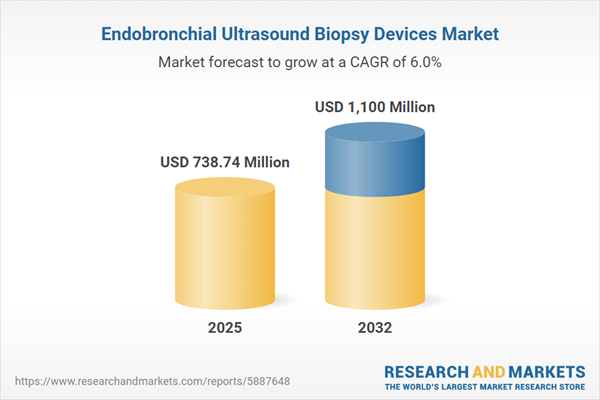Speak directly to the analyst to clarify any post sales queries you may have.
The endobronchial ultrasound biopsy devices market is gaining significant traction as healthcare organizations prioritize minimally invasive diagnostics and seamless clinical workflows. Senior decision-makers are increasingly investing in advanced technology to improve care quality, operational resilience, and scalability across respiratory departments.
Market Snapshot: Global Endobronchial Ultrasound Biopsy Devices Market
The global endobronchial ultrasound biopsy devices market, valued at USD XX billion in 2023 with a CAGR of X.X% through 2030, is advancing rapidly as clinical leaders demand sophisticated respiratory diagnostic solutions. Hospitals and specialty care centers are adopting next-generation devices to drive diagnostic precision, mitigate procedural risk, and streamline the patient journey. Major device manufacturers are reinforcing innovation, while growing market competition is accelerating access to advanced biopsy workflows in developed and emerging healthcare systems. Product differentiation and regulatory agility are shaping provider adoption and standard of care in a diverse range of clinical settings.
Scope & Segmentation: Comprehensive View of the Endobronchial Ultrasound Biopsy Devices Market
- Product Types: Linear and radial probe endobronchial ultrasound biopsy devices offer adaptable solutions for a range of pulmonary procedures, helping clinicians achieve precise access and sample collection.
- Product Offerings: Integrated systems, bundled with needle sets, bronchoscopes, imaging workstations, and procedural sheaths, support a streamlined workflow from initial diagnosis through therapeutic intervention in complex disease presentations.
- End Users: Hospitals, ambulatory surgery centers, and pulmonary specialty clinics benefit from deploying advanced biopsy systems, seamlessly incorporating them into modern diagnostic and interventional practices.
- Applications: Mediastinal staging, transbronchial needle aspiration, and peripheral lung lesion assessment are well-served by innovative ultrasound-guided biopsy devices, contributing to effective short- and long-term care management.
- Indications: Devices enhance early cancer detection, support assessment of infectious and granulomatous pulmonary diseases, and enable multidisciplinary teams to make informed clinical decisions across varying case complexities.
- Regions Analyzed: North America, Europe, Middle East & Africa, and Asia-Pacific provide diverse markets, with key influences stemming from the United States, China, India, and Germany as regulatory and technological innovation hubs.
- Leading Manufacturers: Olympus Corporation, Fujifilm Holdings Corporation, HOYA Corporation, Boston Scientific Corporation, Medtronic plc, and Karl Storz SE & Co. KG are prominent for setting benchmarks in product development and supporting efficient clinical workflows.
Key Takeaways for Senior Decision-Makers
- Artificial intelligence integration into imaging platforms enables more streamlined decision support and simplifies complex pulmonary procedures for clinicians.
- Improvements in probe technology allow better tissue targeting and expand the range of clinical scenarios in which devices can be deployed.
- Facilities equipped with advanced infrastructure and well-aligned reimbursement models adopt new biopsy technology faster, supporting routine integration and increased procedural volume.
- Transition to single-use consumables, such as disposable needles and sheaths, limits workflow interruptions and helps high-volume centers maintain consistent throughput.
- Strategic alliances with suppliers support resilience against evolving regulatory changes and supply chain uncertainty, contributing to operational continuity.
- Ongoing collaboration between device manufacturers and payers informs emerging reimbursement pathways, fostering broader device accessibility and integrated respiratory care delivery.
Tariff Impact on Supply Chain and Cost Structure
Recent changes to U.S. tariffs have prompted manufacturers to reassess supply chains for endobronchial ultrasound biopsy devices, placing greater emphasis on domestic production and transparent procurement to reduce risk. These adjustments improve local supply chain partnerships and sustain product availability, enabling healthcare organizations to adapt quickly to trade and regulation shifts without compromising regulatory compliance or clinical operations.
Methodology & Data Sources
This report utilizes structured interviews with respiratory health and procurement experts, continual market intelligence monitoring, and detailed regulatory reviews. Complemented by quantitative modeling, the methodology ensures robust, actionable insights tailored to decision-makers shaping strategies in advanced respiratory diagnostics.
Why This Report Matters: Strategic Value for Executives
- Empowers executive teams to drive digital transformation, integrate advanced procurement, and improve operational processes throughout the device lifecycle.
- Illuminates shifts in regulatory, clinical, and market trends, allowing stakeholders to strategically allocate resources and stay ahead of sector developments.
- Enables informed investment planning and automation initiatives, strengthening organizational infrastructure and advancing respiratory care delivery.
Conclusion
Investing in innovative endobronchial ultrasound biopsy devices positions organizations to foster agile supplier collaboration and maintain clinical responsiveness. Comprehensive market insights support ongoing improvements in diagnostics and operational excellence throughout the evolving respiratory care sector.
Additional Product Information:
- Purchase of this report includes 1 year online access with quarterly updates.
- This report can be updated on request. Please contact our Customer Experience team using the Ask a Question widget on our website.
Table of Contents
3. Executive Summary
4. Market Overview
7. Cumulative Impact of Artificial Intelligence 2025
Companies Mentioned
The companies profiled in this Endobronchial Ultrasound Biopsy Devices market report include:- Olympus Corporation
- Fujifilm Holdings Corporation
- HOYA Corporation
- Boston Scientific Corporation
- Medtronic plc
- Karl Storz SE & Co. KG
Table Information
| Report Attribute | Details |
|---|---|
| No. of Pages | 196 |
| Published | October 2025 |
| Forecast Period | 2025 - 2032 |
| Estimated Market Value ( USD | $ 738.74 Million |
| Forecasted Market Value ( USD | $ 1100 Million |
| Compound Annual Growth Rate | 5.9% |
| Regions Covered | Global |
| No. of Companies Mentioned | 7 |









